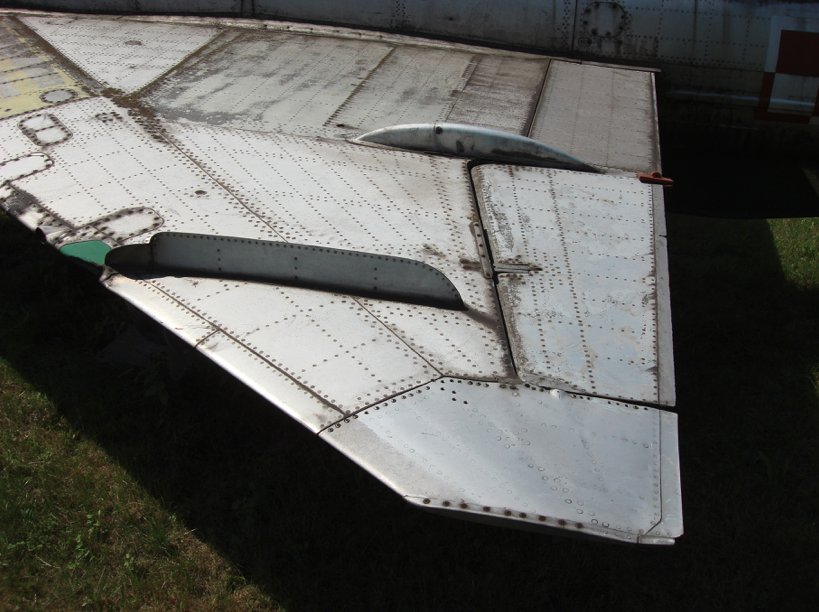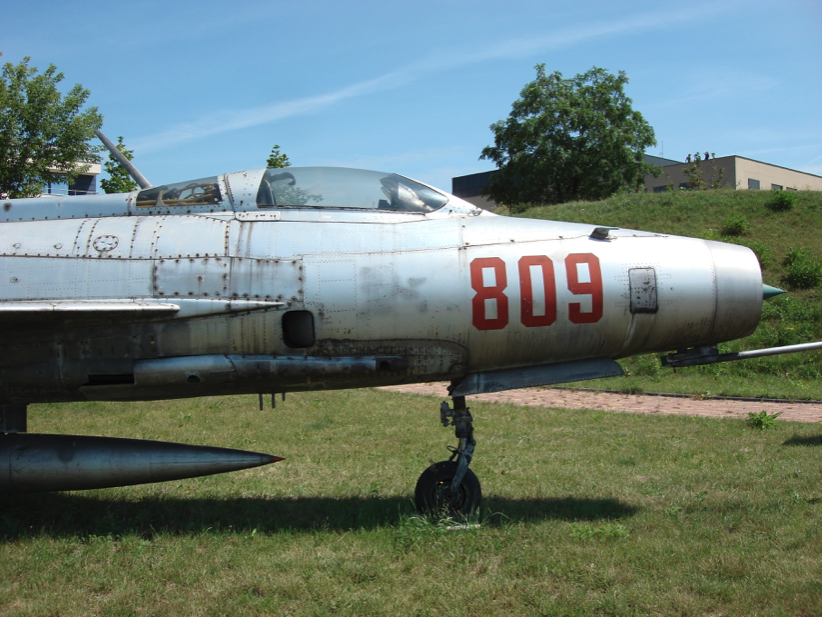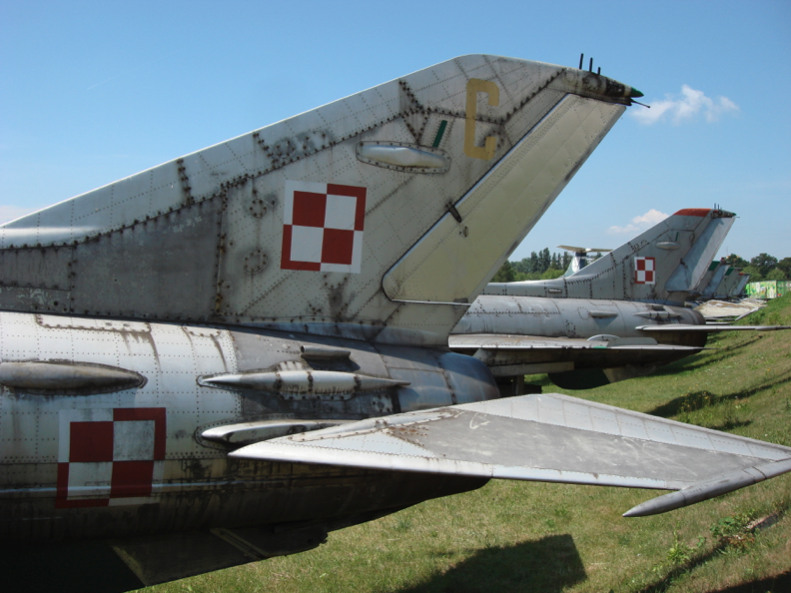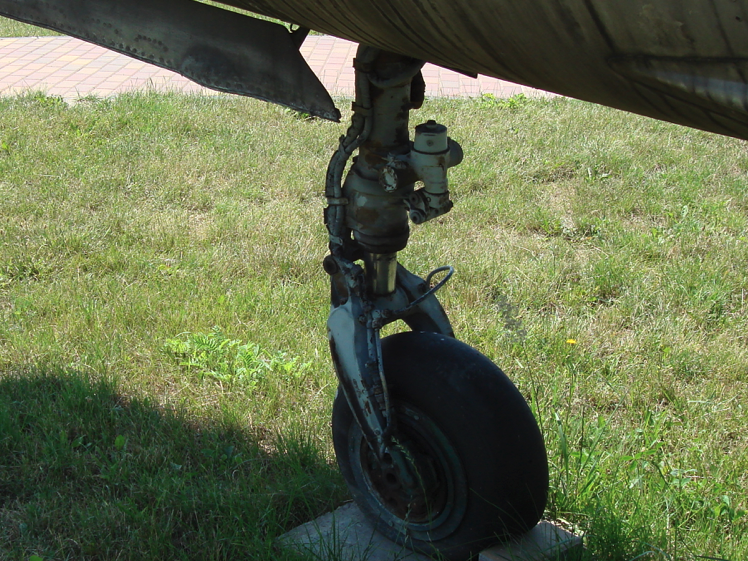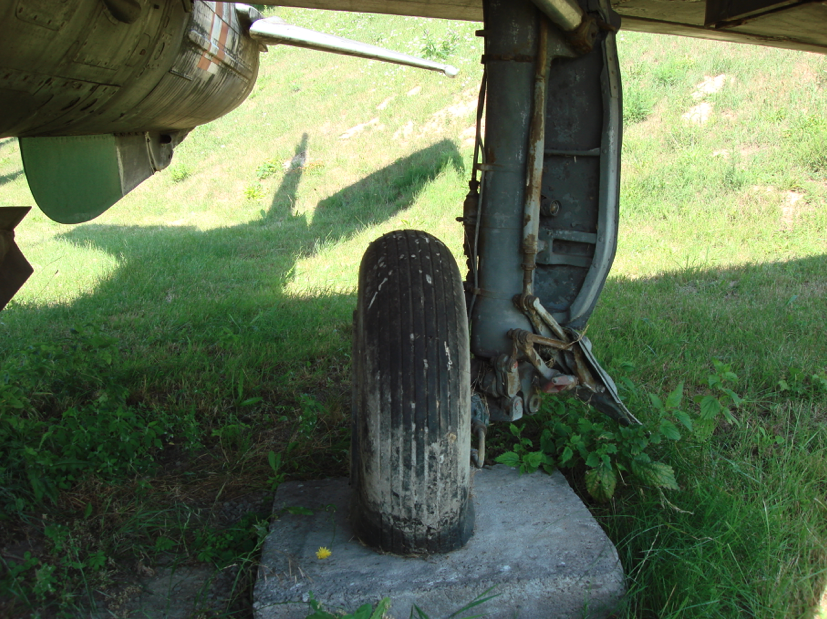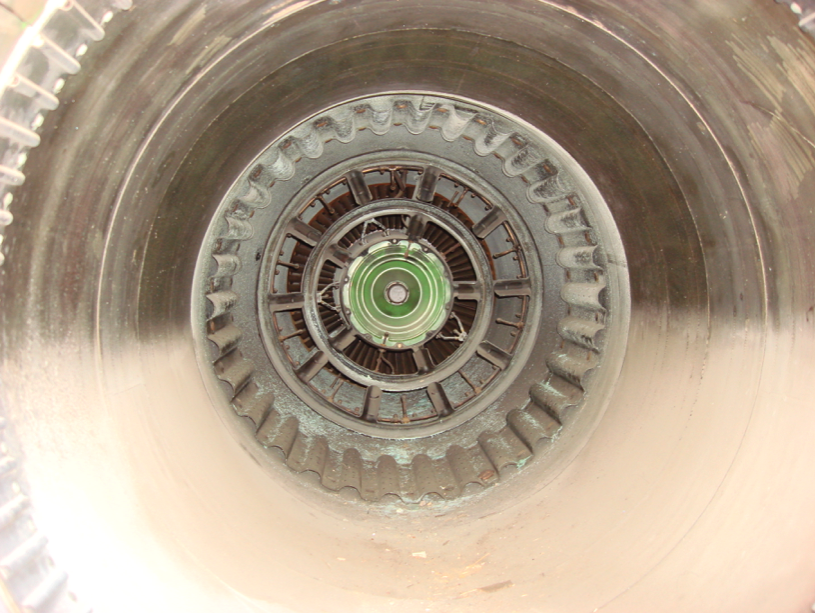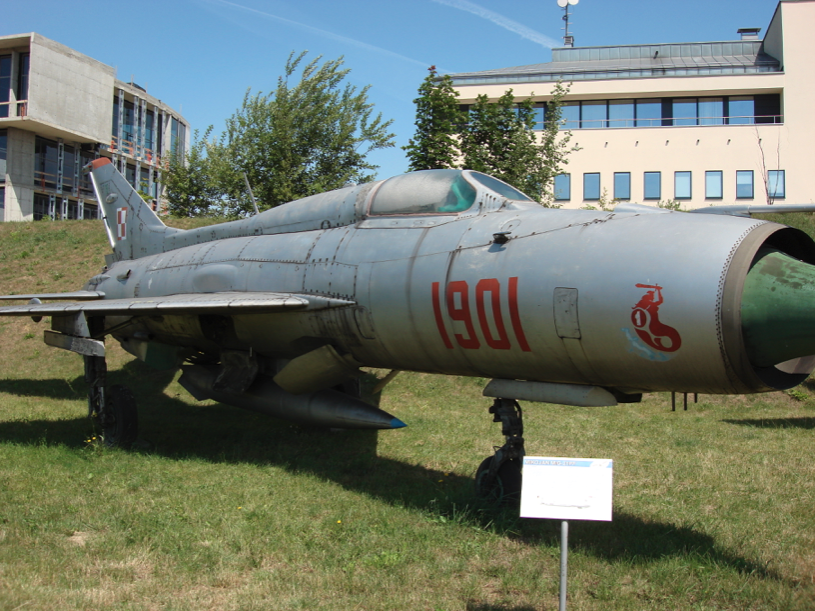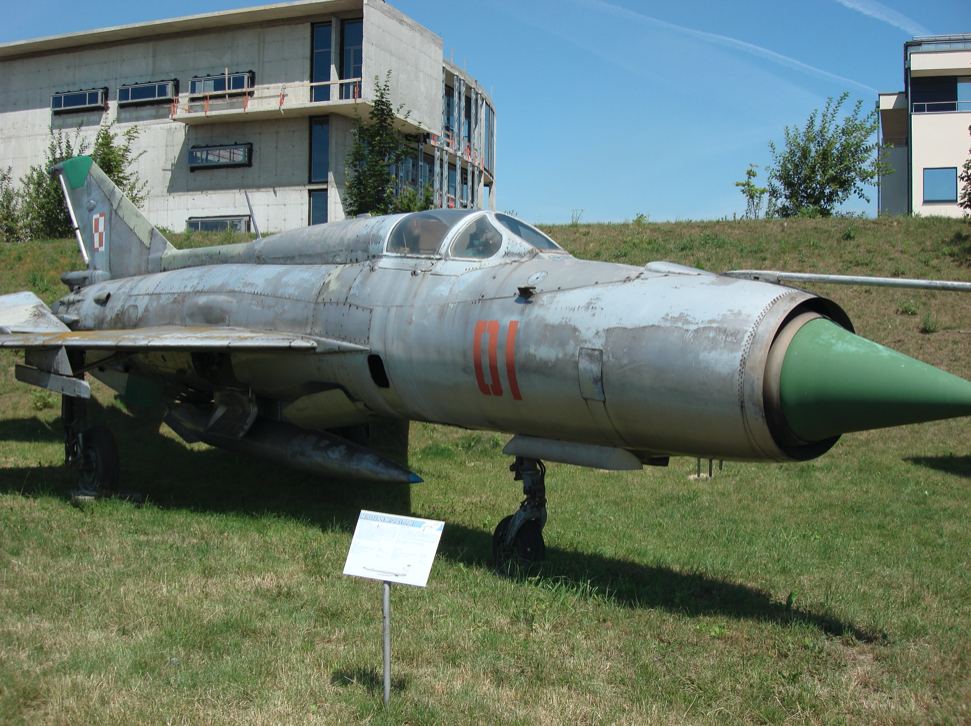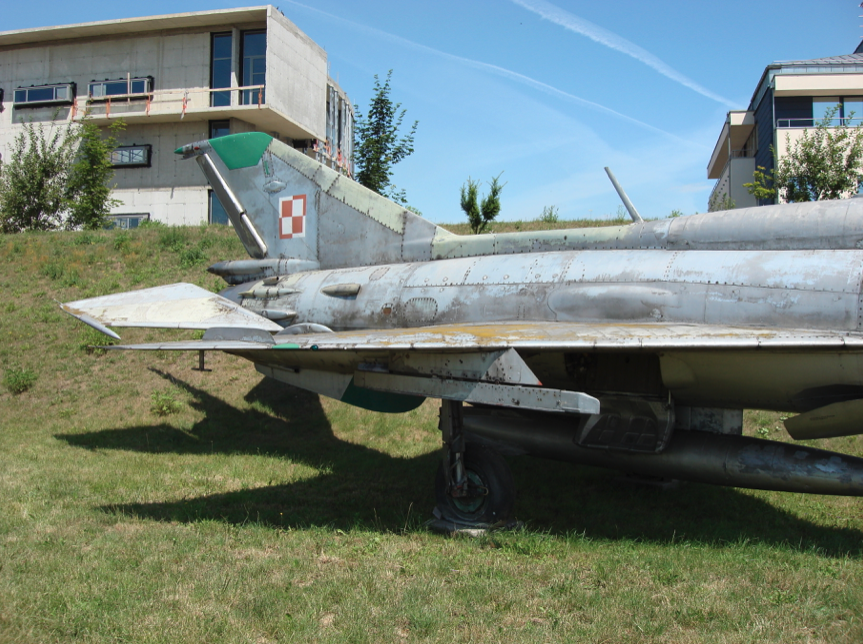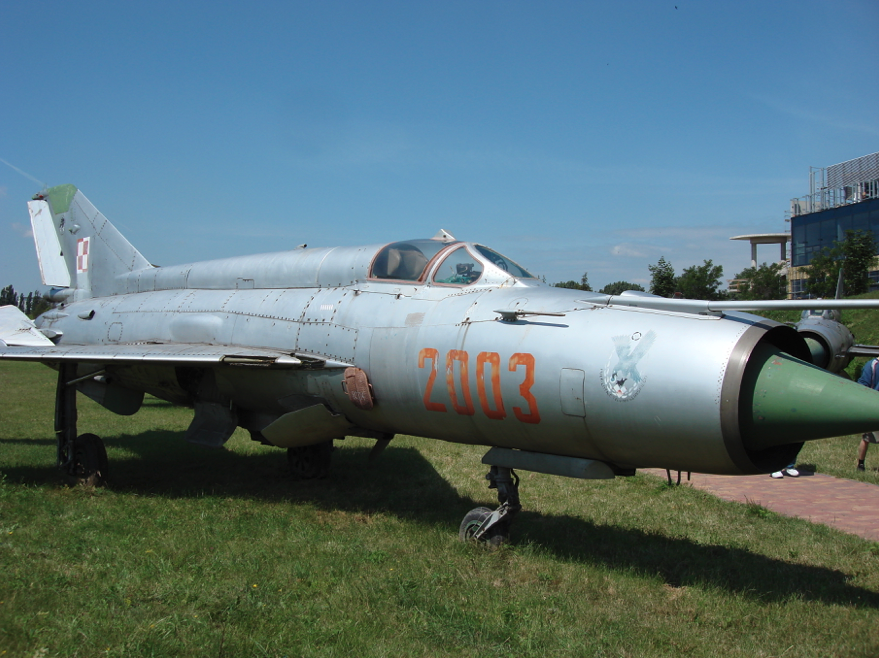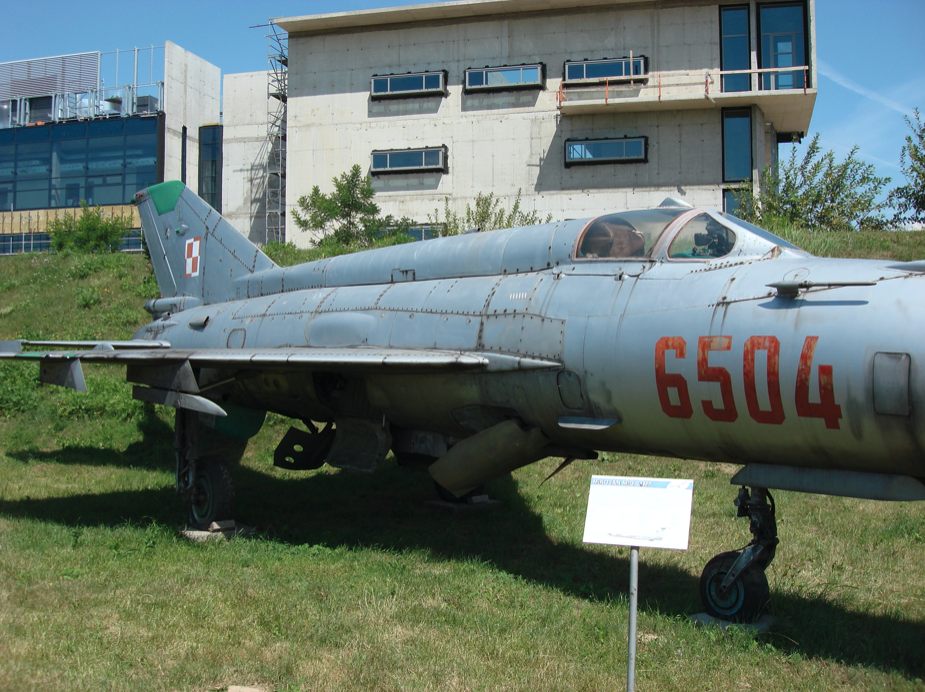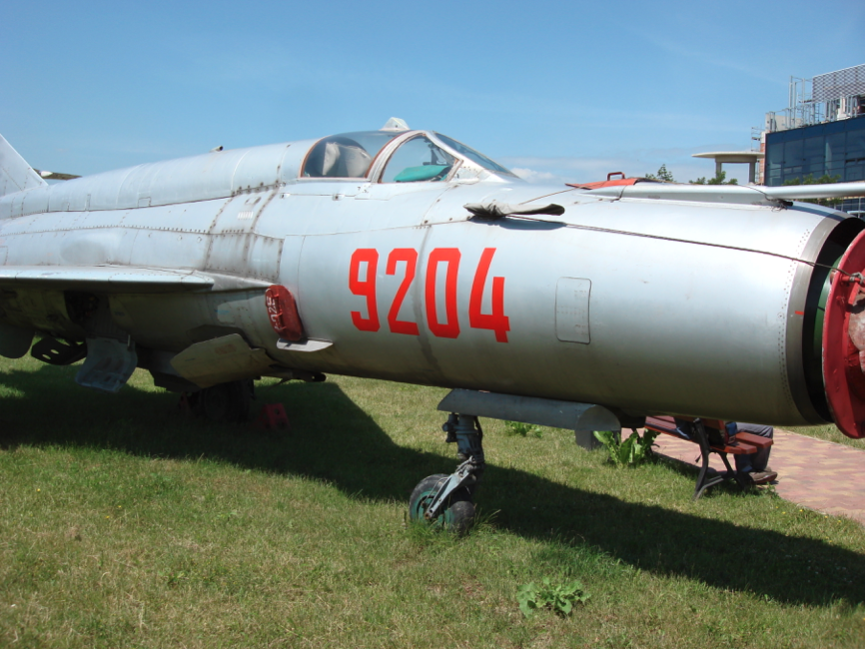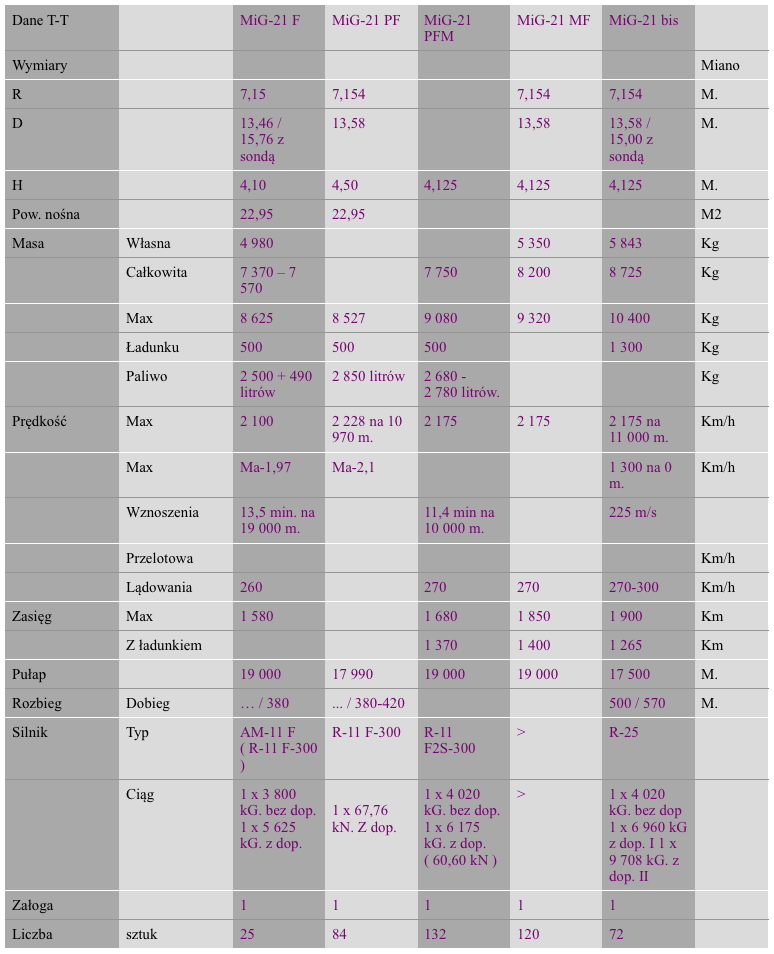Kraków 2007-10-01
180 Section 1961-09-29
OKB Mikojan and Guriewicz MiG-21 in Poland
Poland
History
A supersonic fighter aircraft operating in "all weather conditions".
This article is a synthesis of the history of use of MiG-21 aircraft in the Polish Army. MiG-21 aircraft were used in Poland from 1961 to 2003. The last aircraft were removed from the state in January 2004.
The subject of the license for the production of MiG-21 aircraft in Poland.
For the licensed MiG-21 aircraft, the Lim-7 designation is provided in Poland. The relevant documents were already signed in July 1956 and January 1957. However, at this time the Kremlin’s distrust of the new PZPR authorities, including Władysław Gomułka, increased. On May 24-25, 1957, a delegation from Poland insisted on selling licenses in Moscow. Nikita Khrushchev commented on Polish insistence; "… if all of you can make sure you keep the secret, I won’t believe you."
Finally, at that time, it was only agreed to sell 36 copies of the MiG-19 aircraft to the Polish Army.
Subject experts will notice apparent inaccuracies here that almost in the mid-1950s there is talk about the MiG-21 fighter. But there are no inaccuracies here. The head of CCCP, Nikita Khrushchev, talked here about the MiG-21 aircraft based on the experimental E-5 produced very briefly, not about the later and widely known MiG-21 / E-6.
However, in 1960, the topic of MiG-21 aircraft returned again. It was connected with the "Cuban crisis". The Soviet authorities agreed to sell MiG-21 F aircraft, without the right to manufacture. Has Poland tried to obtain licenses again in the following years? – You don’t know that.
MiG-21 F-13
The OKB Mikojan designers have been given a new, more powerful engine. The AM-11 F engine, which was designated R-11 F-300 in production, has a 1 x 3 800 kG thrust, and with 1 x 5 625 kG afterburning. This engine created real possibilities of building a serial fighter aircraft with Ma-2 flight speed. It was decided to build a prototype, which was designated E-6.
The new aircraft once again received an enlarged fuel installation. The amount of fuel has reached 2,300 liters. In addition, a 490 liter tank could be hung under the fuselage of the aircraft. The wing has also changed. Instead of three pairs, only two pairs of aerodynamic steering wheels were mounted and the wing tips were cut by 0.30 m to improve stiffness. The horizontal crease was lowered down to the plane of the wings. For this reason, instead of two under the fuselage of the aerodynamic steering wheels one central was introduced.
On May 20, 1958, the E-6 prototype flew by Vladimir A. Niefiedow. In one of the following flights, at an altitude of 12,500 m, he reached the speed of 2,175 km / h (Ma-2.05).In the new prototype of the E-6/2 aircraft, the electric emergency control system was replaced by a hydraulic one. The air intake cone has been able to move axially and is automatically in one of three positions. In addition, air vent was installed on the hull.
The E-6/2 prototype piloted by K. K. Kokkinaki made the first flight on September 15, 1958. Then began the tests, which ended February 24, 1959. At the same time, serial production of the aircraft began, under the name MiG-21 F (forsirowannyj) By the end of 1959, 30 aircraft were produced, and the remaining 10 aircraft in 1960. The production plant was a factory in Gorki. There, the aircraft received the Type 72 designation. The aircraft achieved good results in tests. Speed 2 100 km / h (Ma-1.97).
The first three serial machines went to OKB Mikojan. At that time, they received new weapons – the CCP K-13 (R-3). These fighters have been marked; E-6 T / 1, E-6 T / 2 and E-6 T / 3. Together with the K-13 rockets, the aircraft received the SRD-5 M or MK radio rangefinder and the WRD-2 A firing zone calculator (calculator). It determines the effective firing distance of the missile depending on the height, speed of the fighter and approach speed. The left cannon was not installed in the aircraft. Only one left.
The tests of the MiG-21 F-13 aircraft lasted until the end of 1960. In 1960, 114 machines were built. Then the plant went on to build the MiG-21 F-13 (type 74) version. The aircraft received a fuel installation with a capacity of 2,500 liters and several other changes. In this form, the MiG-21 F-13 (type 74) was built in 1960-1962. 551 pieces were built in the Gorki factory and 17 pieces in Tbilisi. Airplanes were built for export in the years 1962-1965. The license was transferred to Czechoslovakia and China.
MiG-21 F-13 for Poland.
At the beginning of the 1960s, the era of fighter aircraft arrived, achieving double the speed of sound. The need to have this type of machine became urgent. The MiG-19 aircraft did not meet all the hopes placed in it. The introduction of the new technique, in the form of MiG-21 F-13 fighters, was often tried to be described as the "second technical revolution in Polish Aviation". (The first revolution was the introduction of the MiG-15, Lim-1/2 aircraft.) However, the MiG-21 F-13 fighters could not be a breakthrough. They didn’t have a radar station. There were only two new elements; twice the speed of sound and p-p missiles with a thermal homing head.
The MiG-21 F-13 is the first variant purchased by Poland. Only new aircraft, manufactured in CCCP at the Gorki plant, came to Poland. The aircraft as a drive has an R-11F-300 engine with 1 x 3 822 kG thrust. and 1 x 5 625 kG. with afterburning.
The first plane was brought to Poland on September 29, 1961, in strict secrecy. The aircraft had serial number 741217 and was issued with the number 1217. It was placed in the Aviation Training Center in Modlin. The plane was heavily guarded and few people had access to it. It is difficult to say today how many flights this copy made in the first months of its stay in Poland. One thing is certain, that regular training has not yet been conducted. Officially, it was to provide assistance in the training of flying and technical personnel.
In parallel, in November 1961, the first group of 16 pilots was sent to CCCP for training. Pilots came from: 62 PLM in Krzesiny and 1 PLM from Mińsk Mazowiecki. Another eight MiG-21 F-13 aircraft were delivered in September 1962. In the autumn of 1962, training began for another group of pilots from selected combat regiments. Another 6 machines went to 1 PLM in Minsk Mazowiecki and almost simultaneously to 11 PLM. Finally, the Polish Army received 25 units.
In 1973, during the Middle East conflict, 12 MiG-21 F-13 aircraft were sold to Syria. The last aircraft of this type were removed from the state in 1978. Whereas the first copy of the MiG-21 F-13 with board number 1217 survived in Zamość until 1994 and was sold to a foreign collector.
MiG-21 PF
During the development of the MiG-21 fighter, the requirements for the weapon system increased. Ultimately, the front fighter was to have the ability to combat air targets day and night in "all weather conditions".
The new requirements were implemented in the E-7 prototype. Changes in construction and equipment compared to the E-6 were large. The front part of the hull was enlarged to accommodate new equipment, and above all the CD-30 radar station. The radar antenna was in the enlarged inlet cone.
To use the radar sight better, the armament had to change. CCP appeared p-p class RS-2 U. These are radiolocation-guided missiles. The fighter was able to cooperate with the Wozduch-1 ground-based guidance system via the Lazur radio receiver. In addition, equipment appeared; response and response device (in English IFF) SPO-2, automatic pilot KAP-1 and RW-UM, RUM ASP-5 N replaced the simple sight with a PKI collimator. Plots were not mounted on the new fighter jet. The aircraft received larger wheels for use of ground airports.
On April 9, 1959, the pilot E-7/1 was flown by pilot Piotr M. Ostapienko. On May 8, 1960, the factory tests came to an end. From June 1960, the factory in Gorki started serial production of machines under the designation MiG-21 P type 76 (pieriechwatczik). At state tests, the operation of the radar station and its too small range aroused reservations. The success was brought only by the E-7/4, which in August and September 1962, passed the factory tests and was directed to production under the designation MiG-21 PF (again type 76). The aircraft received a CD-30 T radar station, which in production was designated RP-21 and RS-2 US missiles.
The radar station detects the bomber at a distance of 20 km, and automatic target tracking starts at 11 km. The aircraft received a more powerful R-11 F2-300 engine with 1 x 3 870 kG thrust, with 1 x 6,000 kG afterburning. The fuel installation has a capacity of 2,780 liters, by adding an over-hull, 7 tank with a capacity of 170 liters. MiG-21 PF was produced at the Gorki factory for own needs in 1962-1964, and for export in 1964-1966.
MiG-21 PF in Poland. 1964.
On April 14, 1964, the first copies of the MiG-21 PF, equipped with the RP-21 radiolocation station, came into service of Polish Aviation. RS-2 US guided by radar system, increased fuel supply and several other news. These planes represented a completely new quality, because, unlike the previous version, they could already operate day and night, in "all weather conditions".
The first 4 MiG-21 PF were accepted as 62 PLM on April 14, 1964. The next two machines were accepted on October 26, 1964. MiG-21 PF planes initially found their equipment: 3 PLM from Wrocław, 13 PLM from Łęczyca, 26 PLM from Zegrze Pomorskie, 40 PLM from Świdwin, 41 PLM from Malbork. By the end of 1964, 17 machines were imported.
In total, Poland bought 85 MiG-21 PF aircraft. Deliveries were completed in 1966. In total, the machines went to nine combat regiments and to technical staff schools in Zamość and Oleśnica. In Polish Aviation, planes served for a very long time. The last 39 units were removed from the state in 1989 as part of arms reduction.
MiG-21 U
A large number of built fighters resulted in the need to provide the army with a two-seater version. The base was the MiG-21 F-13 (type 74). The E-6 U (pupil) prototype made its first flight on October 17, 1960. Piotr Ostapienko was the pilot. The seats were arranged in tandem. The capacity of the fuel installation was 2,350 liters. The plane was deprived of the plot, but in the suspended container under the fuselage there was km. 12.7 mm, with 60 bullets. The tank can be mounted interchangeably with the fuel tank. The aircraft received an on-board telephone SPU-7 and a device imitating damages.
The aircraft in production was designated MiG-21 U (type 66, 66-400). It was built in Tbilisi for own needs in 1962-1966, and for export 1964-1968. A hybrid MiG-21 U (type 66, 66-600) was produced in Moscow with an enlarged vertical tail and a braking parachute at the base of the ballast.
MiG-21 U in Poland. 1965.
Two-seater versions were imported for training purposes. First, they were versions of the MiG-21 U (66-400) imported in May and June 1965. In total, 6 were purchased. 5 MiG-21 U (66-600) machines were purchased along with the MiG-21 PFM. The first of them came to Poland on July 7, 1966. They were removed from the state, three in December 1989 and two in February 1990. The aircraft were handed over to the museums in Kraków and Drzonów.
MiG-21 PFM
On MiG-21 PF aircraft, the take-off and landing characteristics deteriorated. Therefore, two prototypes E-6 W / 1 and E-6 W / 2 were developed. They tested on them, among others; additional launch rockets, landing at increased angles of attack from 10-11 degrees to 16-18 degrees, and above all blowing on flaps. The result of this research was the MiG-21 PFS aircraft (type 94, S from SPS). The aircraft together with the R-11 F2S-300 engine received a flap system, parachute at the base of the vertical tail, with the possibility of opening before the touchdown, with an area increased from 16 m2 to 19 m2. The fighter was produced in Gorki for own needs in 1964-1965, and in Moscow for export in 1966-1968.
MiG-21 PFM in Poland. 1966.
From February 1966, deliveries of the MiG-21 PFM type 94 began. The first batch arrived in Poland on February 4, 1966. The delivery included 10 machines. Another 25 hit on August 5, 1966.
As it turned out, the MiG-21 PFM was the most exploited version in Polish Aviation. In total, 132 MiG-21 PFM aircraft were delivered to Poland. aircraft deliveries were completed in 1969. planes were armed with up to 10 air regiments. Throughout the service, the MiG-21 PFM versions were operated in the following regiments; 4 PLM then 2 PLM in Goleniów, 10 PLM in Łask, 11 PLM in Wrocław, 26 PLM in Zegrze Pomorskie (since 1989 9 PLM), 34 PLM-MW in Babich Doły, 39 PLM in Mierzęcice, 40 PLM in Świdwin, 41 PLM in Malbork, 62 PLM in Krzesiny (since 1995. 3 PLM).
The MiG-21 PFM aircraft were decommissioned on December 11, 1997. The farewell ceremony for the MiG-21 PFM took place at the airport in Krzesiny on March 24, 1998.
MiG-21 R
The MiG-21 R reconnaissance aircraft (Type 94 R) with the R-11 F2S-300 engine with SPS installation was developed based on the MiG-21 PFM. The total capacity of the fuel system is 2,800 liters. To achieve adequate range, the aircraft received an additional two external suspension nodes for 2 x 490 liters fuel tanks. The aircraft received new equipment; autopilot AP-155, warning station SPO-3, which warns from every direction (SPO-2 only from the back). This station fires automatically or manually dipoles from the ASO-21 ejector. You can also manually fire the PRP-26 thermal cartridges from a plane (more commonly known as flares).
The aircraft can move containers; Type R – radio-electronic reconnaissance station; SRS-6, SRS-7 M, Rhomb-4 A, Rhomb-4 B and A-39 photo camera. Type D – for daytime photography of 7 cameras. Type N – for night photography 1 camera UA-47 and 152 illuminating cartridges FP-100. Type T – TV reconnaissance, used only in CCCP, Barij-M apparatus.
MiG-21 R aircraft were built at the Gorki factory in 1965-1971.
MiG-21 R in Poland. 1968.
Poland’s possession of effective reconnaissance aviation has never been underestimated. It can be said that aerial reconnaissance was a priority in Poland. When the MiG-21 R version appeared in the CCCP export offer, our country decided to take advantage of the offer.
In 1968, the first reconnaissance aircraft MiG-21R appeared in Poland, which replaced Lim-2R aircraft. First, there were 2 copies that began service on September 28, 1968. The target number of 36 pieces was reached in 1973. They remained in service for a very long time. The last aircraft were decommissioned in 2000.
Poland purchased D and R reconnaissance tanks. The main base for the MiG-21 R aircraft was 32 PLRT in Sochaczew.
MiG-21 M
In 1968, a significantly modernized fighter appeared. The machine received the designation MiG-21 SM type 15, E-7 SM. It is equipped with an R-13-300 engine with 1 x 3 990 kG thrust, without afterburning and 1 x 6 360 kG, with afterburning. Thanks to the new engine, which has increased efficiency, ground speed increased from 1,200 km / h to 1,300 km / h. During production, the reinforced R-13-300 engine with 1 x 4 010 thrust was installed, and with 1 x 6 478 kG afterburning.
The GSz-23 Ł two-barrel cannon with 200 bullets was permanently installed in the airframe. Armament load increased to 1,300 kg. The R-832 M radio appeared. The capacity of the fuel system was reduced to 2,685 liters, but it was compensated by a 800 liter suspended tank. The aircraft has permanently received the A-39 photo camera. The airframe was equipped with a WRe (SPE-141 E) cartridge and ASO-21 ejectors with PRP-26 cartridges and PPI-26 thermal traps.
The MiG-21 SM aircraft was produced in Gorki in 1968-1974, only for own needs.
MiG-21 M is the depleted version of the MiG-21 SM. The MiG-21 M type 96, E-7 M aircraft received the R-11 F2S-300 or R-11 F2SK-300 engine, R-802 W radio. The MiG-21 M aircraft was manufactured for export in Moscow in 1968-1971 . In 1971, the aircraft license was sold to India.
MiG-21 M in Poland. 1969.
On December 30, 1969, Poland received the first 6 pieces of the MiG-21 M. aircraft. Their introduction allowed the decommissioning of the first supersonic Polish aviation aircraft MiG-19P / PM and MiG-21F-13. Deliveries were completed in 1971. A total of 36 pieces were bought.
Polish MiG-21 M aircraft were delivered in a depleted version; R-11 F2S-300 engines, RP-21 radar station, RS-2 US missiles.
The first machines went to CSL in Modlin. The first combat unit that received the MiG-21 M was 41 PLM in Malbork. This version was also included in the armament of 1 PLM in Mińsk Mazowiecki and 26 PLM (and since 1989, 9 PLM) in Zegrze Pomorskie.
In 1990, there were still 27 MiG-21 aircraft armed, and in 2000, 15 more. Exactly after 30 years of service, MiG-21 M aircraft were withdrawn from flights and deleted.
MiG-21 US
The MiG-21 US variant belongs to the second generation of MiG-21 aircraft. Training and combat version for airplanes with SPS flap installation. In addition to the installation and appropriate engine, the aircraft received a KM-1 U ejection seat in the first cabin, and the KM-1I in the second cabin; opened periscope for the KKO-5 instructor; enlarged tank above the hull, total capacity – 2 450 liters.
The planes were produced in Tbilisi in 1966-1970, for themselves and for export.
MiG-21 US in Poland. 1969.
MiG-21 US training and combat aircraft were purchased for the training of pilots of the MiG-21 M version. The first aircraft started service on August 28, 1969. The last one was delivered on July 25, 1970. A total of 12 items were purchased.
The aircraft received KM-1 U and KM-1 J. seats.
There was only one catastrophe during service. On July 7, 1976, in the crash of the MiG-21 US aircraft with board number 4609, two pilots were killed.
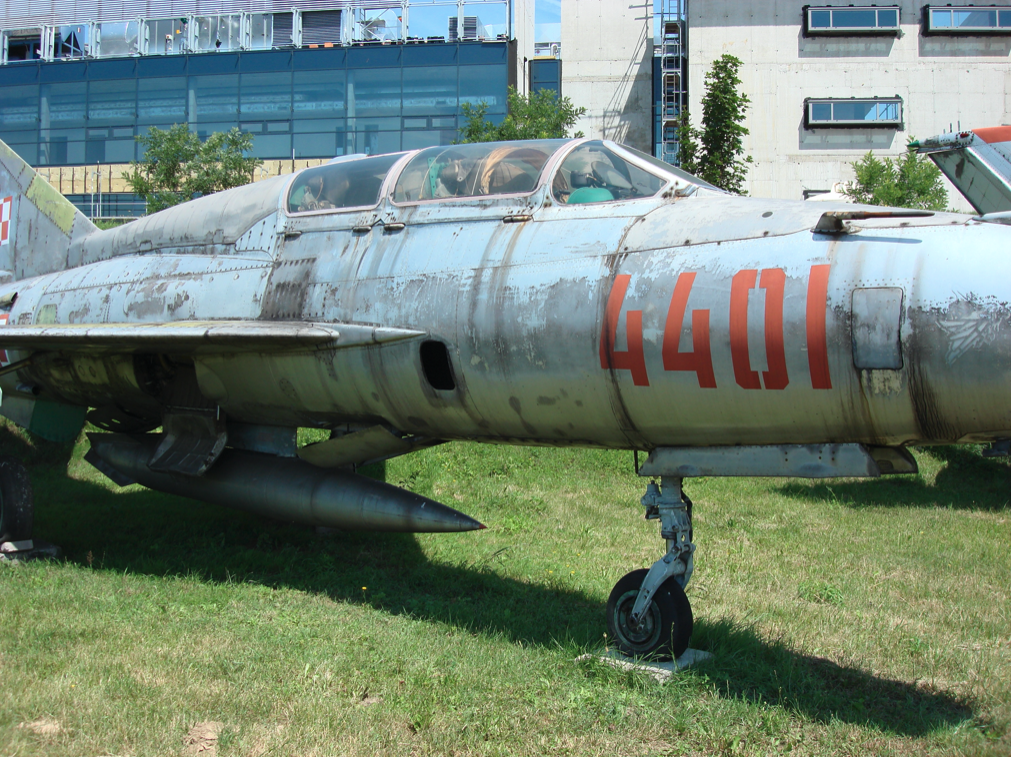
MiG-21 MF
MiG-21 MF type 96 F is a modernized MiG-21 M. It was an export version with the R-13-300 engine and improved equipment. In practice, however, many countries have purchased a lean version with R-11 engines. The aircraft was manufactured at the Moscow factory in 1970-1974, and at the Gorki factory in 1975.
MiG-21 MF in Poland. 1972.
Almost in parallel with the MiG-21 M, the MiG-21 MF type 96A was launched. Deliveries lasted from the end of 1972 to 1975. On December 11, 1972, the first 9 machines were delivered. In total, Poland bought 120 MiG-21 MF aircraft.
During delivery, the MiG-21 MF batch from CCCP was brought in, which questioned the quality of the airframe. Division command refused to accept these planes. They were sent to the producer from Malbork. Therefore, the last batch of 20 MiG-21 MF machines was delivered to us exceptionally from Gorki’s factories. These aircraft have unusual serial numbers with the so-called prefix 96A00. They were adopted on December 11, 1975.
MiG-21 MF planes were introduced: 4 PLM in Goleniów, 10 PLM in Łask, 11 PLM in Wrocław, 26 PLM in Zegrze Pomorskie, 28 PLM in Słupsk, 34 PLM-MW in Babich Doły, 41 PLM in Malbork, 62 PLM in Krzesiny.
The end of use of MiG-21 MF aircraft took place in 2002. 20 items were lost during service (3 in disasters, 16 in failures, 1 due to damage).
MiG-21 UM
For the purposes of training pilots of the 3rd and 4th generation of MiG-21 fighters, a training and combat version of the MiG-21 UM type 69, E-6 UM was developed. These machines were produced in Tbilisi in 1971-1982. 1,133 pieces were built.
MiG-21 UM in Poland. 1971.
This is the last version of the training-combat aircraft bought by the Polish Army. The first planes arrived in Poland on July 26, 1971. The aircraft was delivered in two periods. In the years 1971-1975 and in the years 1980-1981. This second series was used to train pilots of the last purchased version of the MiG-21 bis.
Polish MiG-21 UM type 69 is equipped with; autopilot AP-155, instead of the KAP-2 used so far. Externally, the aircraft received 4 arms. A total of 54 MiG-21 UM machines were purchased.
The last flight on this type was recorded at 41 ELT in Malbork. It was made on December 19, 2003. During operation, 4 aircraft were lost in catastrophes, and 1 in accidents.
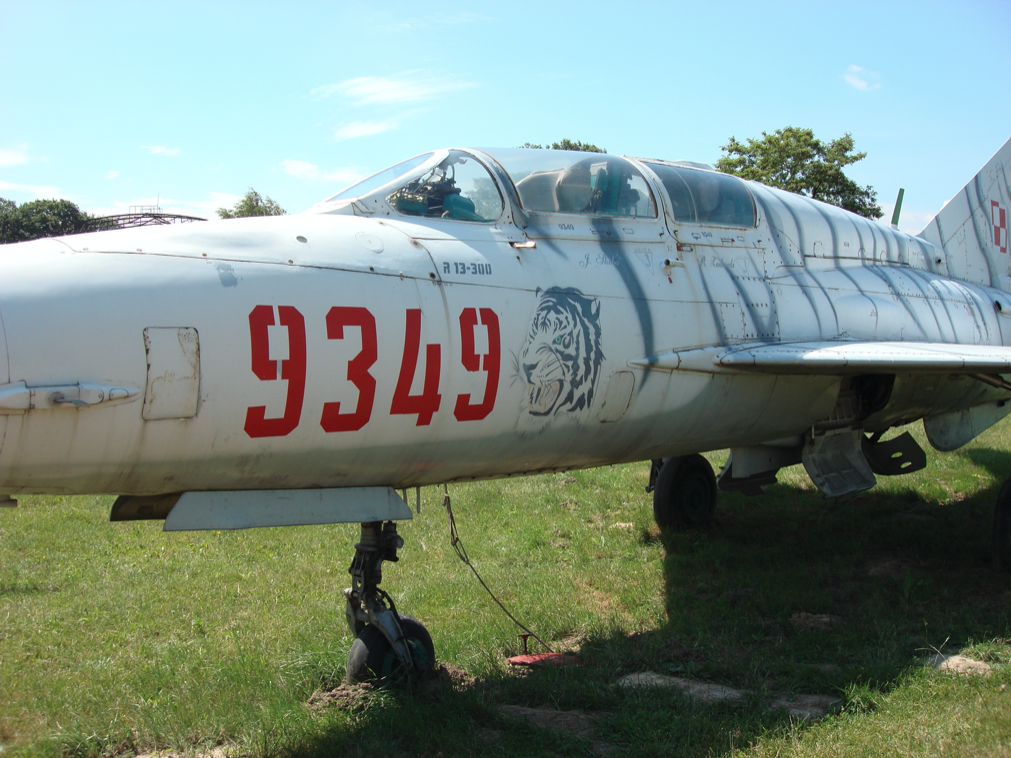
MiG-21 bis.
The MiG-21 bis aircraft belongs to the fourth and last generation MiG-21.
In February 1971, from the experience gained from conflicts in which MiG-21 fighters took part, the concept of expanding the combat capabilities of the aircraft at close distances and at low altitudes emerged. This is how the MiG-21 bis type 75 and E-7 bis were born.
The machine received a new R-25-300 engine with 4 020 / 6,960 kG thrust, with a second afterburning, which allows at Ma> 1 speed and at an altitude of up to 4,000 m, to have 9 720 kG thrust for 3 minutes. The climb speed increased to 225 m / s, when the MiG-21 F-13 is 150 m / s and the MiG-21 SM is 130 m / s. Acceleration time from 600 km / h to 1,100 km / h from 28 seconds decreased to 19 seconds. Operating overloads from 7 g increased to 8.5 g.
The fuel installation reached a capacity of 2 885 liters. The machine was armed in the CCP classes p-p R-13 M and R-55, and later R-60 M.
MiG-21 bis machines were produced in Gorki in 1972-1982, and until 1987, for the needs of India, although in 1980, licenses for these aircraft were sold to India. 2,030 pieces were built.
MiG-21 bis in Poland. 1980.
On February 4, 1980, Soviet pilots brought the first 10 machines to Poland. They entered service on March 6, 1980. In the years 1980–1982 we received 72 copies of the MiG-21 bis version. The purchase of these planes was somehow forced. The second cold war has begun. These aircraft saved us from buying the MiG-25 RB reconnaissance and MiG-25DP interceptors to combat reconnaissance SR-71. In the Warsaw Pact, only Bulgaria purchased the MiG-25. On the other hand, we could have bought more imported since 1980. MiG-23MF fighters, which was not done.
MiG-21 bis aircraft were purchased for 26 PLM (later 9 PLM) in Zegrze Pomorskie and for 34 PLM-MW in Babich Doły. 36 pieces evenly. In 1989, planes from Zegrze Pomorskie began to be transferred to other air regiments.
The last flights on the MiG-21 bis aircraft were performed at 3 ELTs in Krzesiny on December 16, 2003.
Deliveries of MiG-21 aircraft
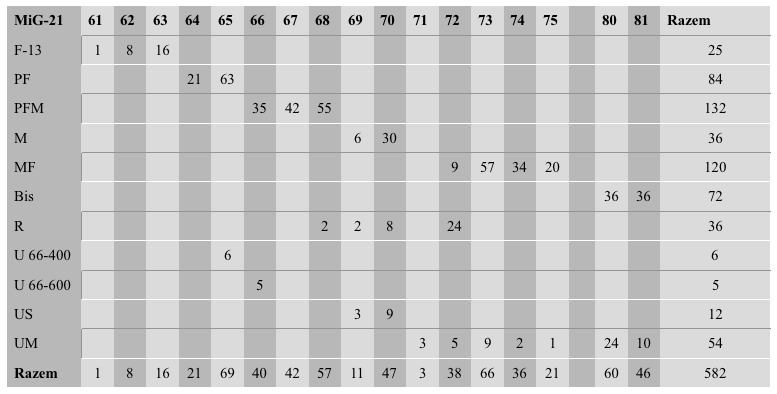
Written by Karol Placha Hetman
Kraków 2007-10-01
180 Section 1961-09-29
OKB Mikojan and Guriewicz MiG-21 in Poland
Poland
Construction
Supersonic fighter aircraft, operating in "all weather conditions".
Construction E-6, MiG-21 F
Single-seat, single-engine, with "delta" wing.
"Delta" wing with bevelled ends (0.3 m), slant 57 degrees, total area 23 m2, symmetrical wing profile CAGI S-12, relative thickness 4.2% at the base and 5% at the end, wedging 0 degrees, elevation -2 degrees, chord at the base 5.97 m, at the end 0.46 m, the structure is the main, auxiliary, front and rear girder. Covering 1.5 to 2.5 mm thick. There are two fuel tanks in each wing. Under the wings, 2 nodes for armament. The wings are equipped with ailerons with a total area of 1.18 m2, swing out 20 degrees. The 1.84 m2 flaps are swung 25 degrees to take off and 45 degrees to land.
Slender fuselage. It begins with a frontal supersonic air grip, centrally equipped with a cone. The cone is movable along the axis and can automatically occupy one of three positions. The cabin protrudes from the fuselage outline. One-piece cab cover. It consists of two windows. Front flat window with bulletproof glass. The rest is made of organic glass in one piece. The rear of the cabin cover, behind the pilot’s seat, also received a window. The cab and horizontal tail are connected by a superstructure hiding the aircraft installation.
Vertical formation, with a 55-degree slope, divided into rudder and ballast. Horizontal slab, also with an angle of 55 degrees, mounted in the plane of the wings. It has anti-flutter masses at the ends. The vertical arrangement is complemented by one under-hull aerodynamic steering wheel.
The MiG-21 PF version has the same vertical tail. However, all subsequent versions of the MiG-21 aircraft have a wider, wider vertical area.
Three-support chassis, all wheels single. The front is retracted forward into the hull. The main landing gear is supported, admittedly in the wings and the shaving retract into the wings, but the wheels rotate, relative to the shin, by 90 degrees and hide in the hull vertically. The chassis base is 4.81 m, and the main chassis wheel track is 2.69 m.
The next versions of the MiG-21 received larger diameter wheels, adapted to use of ground airports.
MiG-21 F-13 power unit
The drive unit consists of a double-shaft turbine AM-11 F (R-11 F-300) with 1 x 3 800 kG thrust, and with post-combustion 1 x 5 625 kG. Fuel in the fuselage and wings. Capacity 2,300 liters. After adding a pair of tanks in the wings, the supply increased to 2,500 liters. Additional tank under the fuselage with a capacity of 490 liters.
MiG-21 F-13 equipment
Equipment; ASP-5 ND optical viewfinder coupled with SRD-5 Quantum radio-distance meter and SIW-52 infrared sight. For reconnaissance flights, instead of the reflector in the left wing, you can take the camera A-39. RW-UM radio altimeter. The SOD-57 M active response device. Other radiotechnical devices are: R-802 W, SRO-2, SPO-2, ARK-10, MRP-56 P.
Armament MiG-21 F-13
The MiG-21 F-13 version has one cannon (right), NR-30, 30 mm, as permanent armament.
Heavy S-21 or S-24 bullets can be hung on two under-wing beams; containers with UB-16-57 U shells; bombs up to 500 kg. But above all, the fighter takes 2 CCP. K-13. The under-body node is used to pick up an additional fuel tank.
Construction MiG-21 PF typ 76
The MiG-21 type 76 aircraft is equipped with the RP-21 M Sapfir radar station.Compared to the first generation (MiG-21 F-13) the major changes consisted of;
- The use of a radar station placed in an enlarged inlet cone.
- The fighter was able to cooperate with the Wozduch-1 ground-based guidance system via the Lazur radio receiver.
- The KAP-1 / KAP-2 / KAP-2 K automatic remote control was installed.
- Only cannon removed. The possibility of hanging the container with the plot was left.
- The range of CCP increased p-p class with RS-2 US missiles cooperating with a radar station.
- Added fuel tank No. 7 on the hull behind the cabin.
- The aircraft is equipped with a device for escaping to a horizontal flight from any situation, e.g. when a pilot has lost spatial orientation.
- Front aerodynamic brakes increased from 0.76 m2 to 0.884 m2.
- The pitot probe was moved over the air inlet.
- The aircraft received larger wheels for use of ground airports.
Clearly visible larger inlet cone and entire front fuselage section. The superstructure can be seen above the fuselage with the 7th tank. No parcel under the fuselage.
MiG-21 PF power unit
The aircraft received a more powerful R-11 F2-300 engine with 1 x 3 870 kG thrust, with 1 x 6,000 kG afterburning. The fuel installation reached a capacity of 2,780 liters by adding an over-hull seventh tank with a capacity of 170 liters.
Armament MiG-21 PF
In the armament of the MiG-21 PF are directed RS-2 US missiles.
Construction MiG-21 PFM typ 94
- Changes compared to MiG-21 PF type 76.
- A new power unit was used.
- The drive has an additional installation of blowing on wing flaps, which improves take-off and landing characteristics.
- The SPRD-99 U2 start accelerators with adjustable thrust from 1 280 kG can be attached to the fuselage. up to 3,230 kG., and thus different operating times – from 9.8 seconds to 17.8 seconds. Engine thrust also depends on weather conditions, temperature, humidity and pressure. The weight of one is 221 kg.
- The container with the braking parachute was moved to the base of the vertical tail and its area increased to 19 m2. Now the parachute can be opened before the touchdown at a speed of less than 320 km / h.
- Vertical fixture with an increased area of 5.32 m2.
- A new KM-2 catapult chair was used.
- The new catapulted chair made it possible to change the cabin glazing. Now it consists of a stationary windbreak with three windows and a fairing tilted to the right by hand.
- The RP-21 M radar station is more sensitive to interference.
- The aircraft was able to suspend a container with a GSz-23 Ł double-barrel cannon with a supply of 200 rounds.
The new cabin cover for the MiG-21 PFM aircraft is clearly visible.
MiG-21 PFM type 94 drive unit
R-11 F2S-300 power unit with 1 x 4 020 kG. Post-combustion thrust, with 1 x 6 175 kG afterburning. Single-flow engine, two-shaft, 3 stages of the compressor of one shaft, 5 stages of the other, 1 turbine of one shaft and 1 turbine of the other shaft, afterburner. Engine length 4.61 m, diameter 0.967 m, weight 1 210 kg. Fuel installation with a capacity of 2 780 liters.
Construction MiG-21 R
The MiG-21 R reconnaissance aircraft (Type 94 R) with the R-11 F2S-300 engine with SPS installation was developed based on the MiG-21 PFM. The tank no. 1 was removed from the fuselage, the tank for fuselage no. 7 was increased to 340 liters. The total installation capacity is 2 800 liters. To achieve adequate range, the aircraft received an additional two external suspension nodes for 2 x 490 liters fuel tanks. Interestingly, the aircraft for repositioning has the ability to carry up to 3 suspended tanks. Ground speed limited to 1 150 km / h. A set of cameras was placed in the place of the first fuel tank.
Construction MiG-21 M
The MiG-21 R is the fifth version introduced to Polish armament. The MiG-21 R aircraft belongs to the third generation of MiG-21 aircraft.
Changes made to the MiG-21 M:
- Polish aircraft do not have a newer R-13-300 engine.
- The GSz-23 Ł two-barrel cannon with 200 bullets was permanently installed in the airframe.
- Armament load increased to 1,300 kg.
- The capacity of the fuel system was reduced to 2 685 liters, but it was compensated by a 800 liter suspended tank.
- The aircraft has permanently received the A-39 photo camera.
- The airframe is equipped with a WRe (SPE-141 E) cartridge (for electronic warfare) and ASO-21 ejectors with PRP-26 cartridges and PPI-26 thermal traps.
Construction MiG-21 ( SM, M ), MF
The most important difference in appearance is the pitot tube slightly shifted to the right. This is the new type PWD-7. The TS-27 AMSz periscope appeared on the cabin cover. The superstructure on the hull, where there are fuel tanks, was enlarged. Four nodes for armament were used. The pressure in the main landing gear wheels has been increased. An R-13 engine was used, but in practice many machines had engines from previous R-11 versions. It depended on the ordering party.
Construction MiG-21 bis
MiG-21 bis is the seventh version introduced to the armament of Poland, the last combat and the last in terms of time. the equipment was improved, and above all the new engine used. The new engine has two afterburning stages. The armament was modernized.
The drive unit is the R-25-300 engine, with 1 x 4 020 kG thrust without afterburning, with 1 x 6 960 kG afterburning, with 1 x 9 708 kG afterburning. Single-flow engine, two-shaft, 3 stages of one shaft compressor, 5 stages of the other, 1 turbine of one shaft and 1 turbine of the other shaft, two boosters. Engine length 4.61 m, diameter 0.967 m, weight 1 210 kg. Fuel installation with a capacity of 2 885 liters.
Armament MiG-21 bis
The machine is equipped with a RP-22 SM radar station and a semi-automatic guidance system for Lazur-M air targets. It ensures that the aircraft is led out to the rear half-zone of the target, intercepting and attacking individual targets detected by radar, in the altitude range of 1,000 m to 17,500 m, at speeds up to 1,600 km / h, all "all weather conditions". This attack can be carried out with R-3 S, R-13 M, R-55, R-60 M missiles, or R-3 R missiles with radar guidance head. The number of shells taken is up to 4 pieces, only R-60 M can carry 6 pieces (two on the internal nodes). Various weapon combinations are possible.
The scanning radar sweeps the space horizontally 30 degrees, vertically 17 degrees up, 15 degrees down. Tracking leads in a 3 degree cone.
Slow flying and ground targets can be fought by eye contact with the ASP-PFD-21 sight.
Fighting ground or surface targets is possible from horizontal flight, at speeds of 700 km / h to 1,000 km / h, with S-5 missiles from 25-100 m. Bombardment is carried out from 300 m, with standard and incendiary bombs. The attack from a dive flight is performed up to an angle of 40 degrees, in the speed range of 600 – 1,000 km / h, with S-5, S-24 B missiles, or CCP with thermal heads for thermal radiation sources. Missiles S-5 come in a variety of variants to combat weakly armored, heavily armored and flying targets. They are always fired from 16- or 32-pipe containers. Missiles S.-24 aircraft can take 4 pieces. They are fired from rail launchers.
The GSz-23 Ł cannon has a supply of 200 rounds. It is a 23mm two-barrel cannon.
The bombs used for the fighter have mass; 50, 100, 250 or 500 kg.
Data T-T MiG-21
Written by Karol Placha Hetman
Krakow, October 10, 2007
180 Section 1961-09-29
OKB Mikojan and Guriewicz MiG-21 in Poland
Poland
Tally
Supersonic fighter aircraft, operating in "all weather conditions".
The tallys are included in the Sections of individual versions of MiG-21 aircraft.
Written by Karol Placha Hetman


